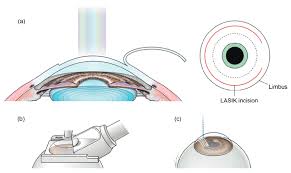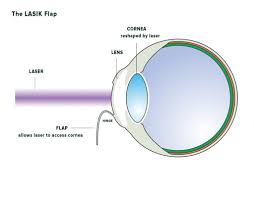Table of Contents
ToggleLASIK eye surgery is a popular and effective procedure designed to correct vision problems such as nearsightedness, farsightedness, and astigmatism.
Millions of people have undergone the procedure with great success, experiencing clearer vision and a significant reduction in or complete elimination of their need for glasses or contact lenses. However, like any surgical procedure, LASIK requires careful preparation to ensure the best possible outcome.
Whether you are considering LASIK or have already scheduled your surgery, it’s crucial to understand what steps to take before the procedure. This comprehensive guide will walk you through everything you need to do before LASIK eye surgery to increase your chances of a successful result.
Understanding LASIK Eye Surgery
Before we explore the pre-surgery steps, let’s quickly understand what LASIK is. LASIK (Laser-Assisted In Situ Keratomileusis) involves reshaping the cornea using a precise laser to improve the way light is focused on the retina. This correction improves vision and reduces dependence on corrective lenses.
Step 1. Conduct thorough research and select a qualified LASIK surgeon.
Selecting the appropriate surgeon is among the most critical decisions in your LASIK journey. The surgeon’s expertise and experience can profoundly influence the outcome of your procedure. Here are some tips for finding a qualified LASIK surgeon:
- Board Certification: It is imperative to verify that the surgeon is board-certified in ophthalmology. Certification signifies that the surgeon has fulfilled the requisite standards and qualifications.
- Experience: Look for a surgeon with extensive experience in performing LASIK surgeries. Surgeons who have performed numerous LASIK procedures are more likely to have refined their skills and techniques.
- Referrals and Reviews: Seek recommendations from friends, family, or your eye doctor. Online reviews and testimonials can offer valuable insights into the experiences of former patients.
- Consultation: Arrange consultations with several surgeons to discuss your particular requirements and expectations. This will help you gauge their expertise and communication style.
Step 2. Undergo a Comprehensive Eye Examination
A thorough eye examination is essential before LASIK to determine if you are a suitable candidate for the surgery. During this examination, your ophthalmologist will evaluate several facets of your ocular health, including:
- Corneal Thickness: The thickness of your corneas is a critical factor in determining your eligibility for LASIK. Thin corneas may not be suitable for the procedure.
- Pupil Size: Large pupils can lead to complications such as glare and halos after LASIK. Your doctor will measure your pupil size to assess the risk.
- Refractive Stability: Your vision prescription should be stable for at least a year before LASIK. Significant changes in your prescription could indicate unstable vision.
- Overall Eye Health: Conditions such as dry eyes, glaucoma, or cataracts may affect your candidacy for LASIK. Your doctor will evaluate your overall eye health.
Step 3. Follow Pre-Surgery Instructions
Once you are deemed a suitable candidate for LASIK, your surgeon will provide specific pre-surgery instructions. Following these instructions is crucial for minimizing risks and ensuring a smooth surgery process. Common pre-surgery instructions include:
- Discontinue Contact Lens Use: Contact lenses can alter the shape of your cornea, so you will need to stop wearing them for a certain period before the surgery. The duration varies based on the type of lenses you use:
- Soft lenses: Discontinue use for at least 1-2 weeks.
- Rigid gas permeable (RGP) lenses and hard lenses: Discontinue use for 3-4 weeks or longer.
- Avoid Makeup and Lotions: On the day of the surgery, avoid wearing makeup, creams, perfumes, and lotions. These products can introduce particles and residues to the surgical area, increasing the risk of infection.
- Arrange Transportation: You will need someone to drive you home after the surgery, as your vision may be blurry immediately following the procedure.
Step 4. Understand the Risks and Benefits
While LASIK is generally safe and effective, it’s essential to understand the potential risks and benefits. Your surgeon will discuss these with you during your consultation, but here are some key points to consider:
Benefits of LASIK
- Improved Vision: Most patients achieve 20/20 vision or better after LASIK, significantly reducing their reliance on glasses or contacts.
- Quick Recovery: The recovery time for LASIK is relatively short, with many patients returning to normal activities within a day or two.
- Long-Lasting Results: The effects of LASIK are typically permanent, though some patients may require enhancements or touch-ups over time.
Risks of LASIK
- Dry Eyes: Some patients experience dry eyes temporarily after LASIK. This condition usually resolves within a few months.
- Halos and Glare: Nighttime glare and halos around lights are possible side effects, especially in patients with large pupils.
- Undercorrection or Overcorrection: While rare, there is a possibility of undercorrecting or overcorrecting vision, requiring additional procedures.
Step 5. Prepare for the Day of Surgery
The day of your LASIK surgery is an exciting step toward clearer vision. To ensure a smooth experience, consider the following preparations:
- Comfortable Attire: Wear comfortable, loose-fitting clothing on the day of your surgery. Avoid clothing with extraneous fibers or fuzz that could come into contact with your eyes.
- No Makeup or Jewelry: As mentioned earlier, avoid wearing makeup, lotions, perfumes, and jewellery. This minimizes the risk of contamination.
- Bring a Companion: Arriving with a trusted friend or family member provides emotional support and transportation after the procedure.
- Arrive Early: Arrive at the clinic early to complete any necessary paperwork and allow yourself time to relax before the surgery.
Step 6. Know What to Expect During Surgery
Understanding the LASIK procedure can ease any anxiety you may have. Here is a brief overview of what you can expect:
- Numbing Drops: Your surgeon will administer numbing eye drops to ensure you don’t feel any pain during the procedure.
- Eye Positioning: A device called a speculum will gently hold your eyelids open while the surgeon creates a flap on the cornea.
- Laser Reshaping: Using a precise laser, the surgeon will reshape your cornea to correct your vision. The laser treatment typically takes less than a minute per eye.
- Flap Replacement: After reshaping, the corneal flap is repositioned to allow for natural healing.
Step 7. Post-Surgery Care and Recovery
Post-surgery, it is essential for your eyes to have adequate time to heal. Adhering to the post-operative care instructions provided by your surgeon is essential for ensuring a successful recovery.
- Avoid Rubbing Your Eyes: Do not rub or touch your eyes, as this could dislodge the corneal flap.
- Use Prescribed Drops: Your surgeon will prescribe antibiotic and anti-inflammatory eye drops to prevent infection and reduce inflammation. Follow the recommended dosage schedule.
- Attend Follow-Up Appointments: Regular follow-up visits with your surgeon allow them to monitor your healing progress and address any concerns.
- Rest: Allow your eyes to rest, especially in the first 24 hours after surgery. Avoid strenuous activities and screen time.
Parting Shots
Preparing for LASIK eye surgery requires adherence to several critical steps to guarantee a smooth and successful procedure. Researching your surgeon, undergoing a comprehensive eye examination, and following pre-surgery instructions are critical components of the preparation process. Understanding the risks and benefits of LASIK, along with knowing what to expect during and after the surgery, will help you feel confident and informed as you move toward a clearer vision.
By taking the time to prepare properly for LASIK, you are investing in the long-term health and clarity of your vision. If you are ready to take the next step and explore the possibilities of LASIK, consult with a qualified surgeon to discuss your options and begin your journey toward improved vision.
Remember, LASIK is just one part of maintaining healthy vision. Continue to prioritize regular eye exams and practice good eye care habits to ensure optimal eye health for years to come.













